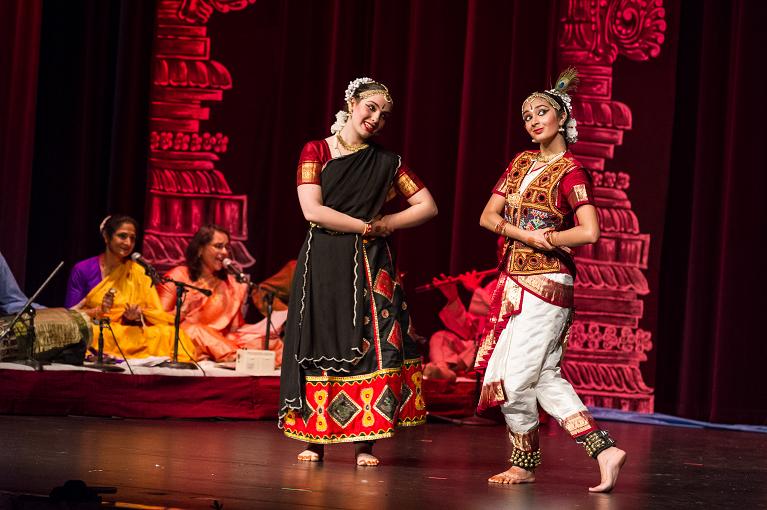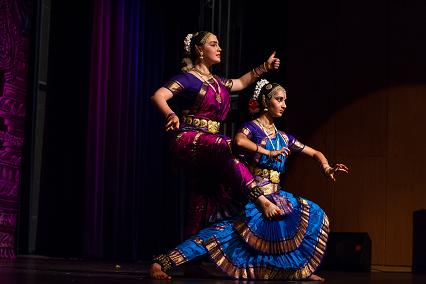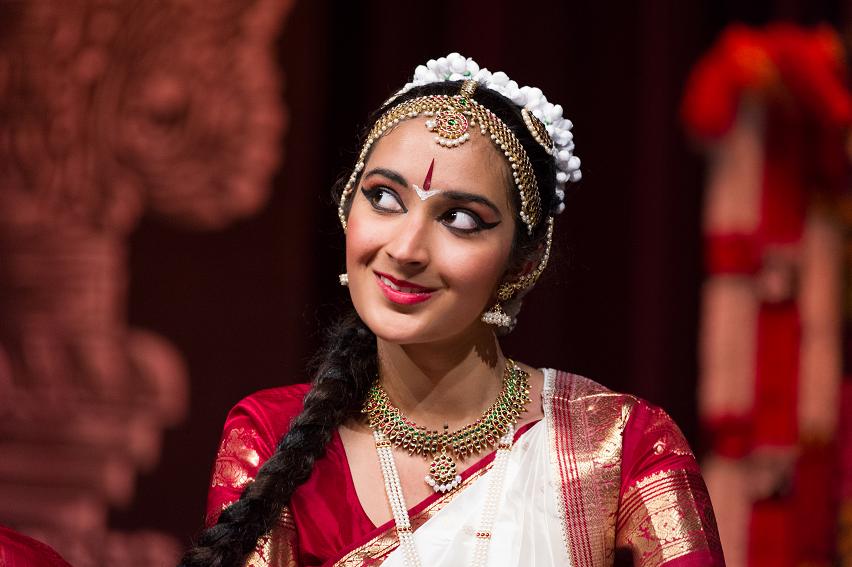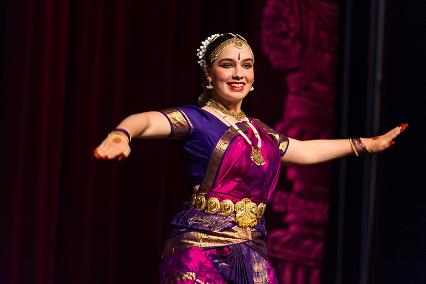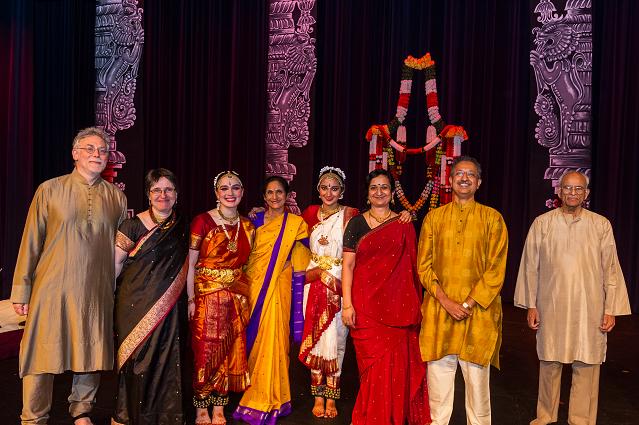Contribute
| Dance Arangetram: Suma Anand And Maya Domeshek |
T.N. “Yan†and Varsha Jayaram
09/12/2013
Suma Anand and Maya Domeshek-‘SuMaya’, two danced as one on a beautiful sunny Sunday in the stately and ample Maxwell Auditorium at the Scottish Rite Masonic Museum in Lexington, Massachusetts on August 4, 2013.
Suma Anand and Maya Domeshek, who are both students of Guru Smt. Neena Gulati, Director of Triveni School of Dance, presented their Arangetrams, their formal inaugural stage performances. Suma and Maya danced a delightful combination of Bharatanatyam and Kuchipudi pieces. These are the classical dance forms that originated from South India, Bharathanatyam from Tamil Nadu and Kuchipudi from Andhra Pradesh. Each carries its own flavour, rich in culture and brimming with wondrous history. Bharathanatyam is a reworked variety of dance from the traditional temple dance form, known for its grace, purity, tenderness, and sculpturesque poses. Very similar to Bharathanatyam, Kuchipudi found its origin in a small village of the same name in Andhra Pradesh. The songs in Kuchipudi are mimed with alluring expressions, swift looks and fleeting emotions. The two girls did full justice to both styles and demonstrated tremendous grace, form, emotion and coordination throughout the performance.
The recital began with a traditional opening piece of paying respect to Lord Ganesha, the Ganapathi Vandana, in Gowla Ragam, performed in Kuchipudi style. The next item was an energetic and lively Jatiswaram in the beautiful ragam of Mandari, also set in Kuchipudi style. The Jathiswaram is an item that is choreographed by weaving the classical notes of the music with the quick footwork of the artistes, wherein the “pure dance†aspect is highlighted. Suma and Maya jointly performed the above two pieces. The choreography was imaginative and coordination between the two dancers was impeccable.
The next was a Shabdam by Maya, in Kuchipudi style, on Lord Rama. A rare and one of the oldest choreographies, this piece narrated the entire Ramayanam epic through dance. Ramayana enthusiasts and novices in the spell bound audience were equally feasted to Maya’s skillful conjuring of the entire story. Starting with the birth of Rama, Maya then portrayed the Rama-Sita Wedding, the devious Mareecha tricking Sita and Rama in the form of a deer while Ravana whisked Sita away, Jatayu valiantly fighting Ravana, Rama partnering with the army of apes to find Sita in Lanka, eventually vanquishing Ravana and rescuing Sita, and returning victoriously to Ayodhya to the delight of everyone around.
The Varnam, the crown jewel of an Arangetram recital, followed next. Set in the moving Raga, Simhendra Madhyamam, and performed in the Bharatanatyam style, Suma and Maya brilliantly and effortlessly portrayed the fierce goddess Parvati and how she vanquished Mahishasura. The duo was equally well versed in Nritta as they were in Abhinaya and performed the Varnam with gusto and grace, while covering the entire stage well. The energetic poses during the dramatic moments of the Varnam were met with appropriately enthusiastic thunderous applause from the audience.
After the intermission, we were treated to Suma’s solo, a Krishna Shabdam, performed in Kuchipudi style, and set to the Mohana Ragam. This classic Kuchipudi piece was colorfully brought to life by Suma, who entranced us with an enjoyable portrayal of the divine and loving relationship between a gopika and Krishna. The beauty of this relationship was brought to life through Suma’s Abhinaya throughout the piece. Through Suma, the audience was able to experience the potpourri of gopika’s emotions ranging from deep love to casual flirtations, and from playful teasing to complete surrender to Krishna’s charms.
The three dances that followed fully made use of the duo, with SuMaya portraying the iconic pairs of Krishna-Yashoda, Parvathi-Shiva, and Kalinga-Krishna.
The first of these pieces is another classic, set in Bharatanatyam style, in Ragam Yamunkalyani-Krishna Nee Begane Baaro. With the focus on the sublime relationship between Yashoda and Krishna, this piece portrayed the captivating beauty of Krishna, his enthralling music, his playfulness, his ability to mesmerize all who come in contact with him, and concluding with his divinity when He portrays the entire universe in his mouth to his mother who naively thinks that all it would show was the dirt he had eaten in the playground! Maya simply transformed into Yashoda, with Suma bringing Krishna to life. The audience lapped up all the key moments of this piece, from the scolding Yashoda, to the guilty Krishna caught in the act, culminating in the magnificient realization of Yashoda when she finds out the truth about Krishna-the lord of the Universe.
Next, Suma and Maya entertained us as Shiva and Parvathi, portraying the cosmic dance, vividly displaying river Ganga flowing through Shiva’s matted locks, serpents surrounding his throat, his trident, his damaru, and garland of skulls.
The third and a very unique piece was a Thillana in Ragamalika. Similar to the previous piece, the style was in Kuchipudi, with a liberal sprinkling of lyrics presented in prose form. This and the fact that the story is perfect for dance – Krishna’s kalinga narthanam – was the fitting finale of this Arangetram.
And the icing on the cake was the Tarangam, one of the signature items of Kuchipudi, with the balance and sheer athleticism in display when the girls danced on a brass plate.
The abhinaya, nritta, and natya of Suma and Maya were brilliantly complemented by the orchestra, which encompassed stalwart artistes of Greater Boston including vocalist Smt. Maitreyi Sharma, violinist Sri. Surya Sundararajan, Mridangist Sri. Gowrishankar Chandrashekar, flutist Sri. Suresh Mathur, and finally the incomparable, passionate, and brilliant Smt. Neena Gulati providing the Nattuvangam.
You may also access this article through our web-site http://www.lokvani.com/
